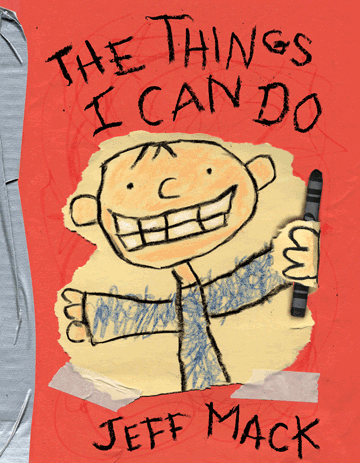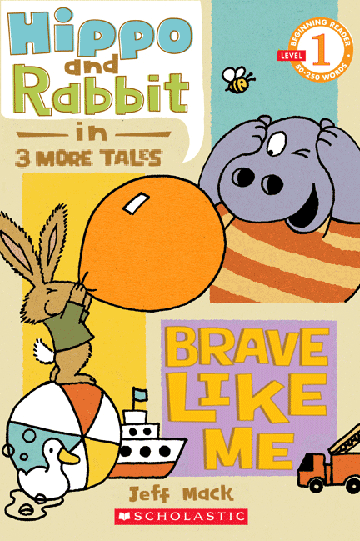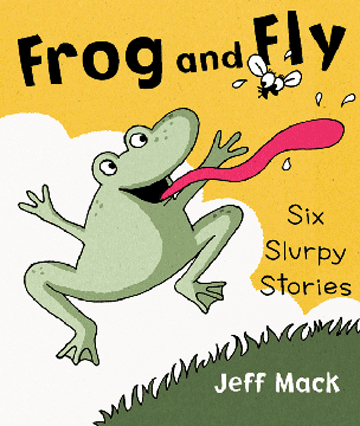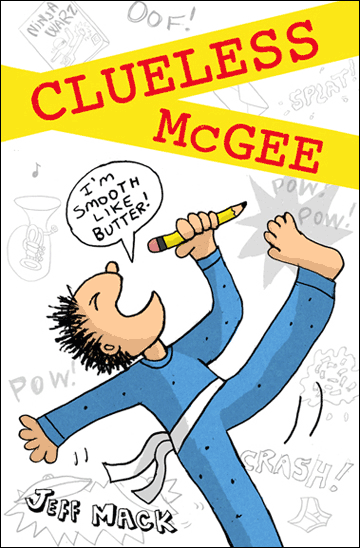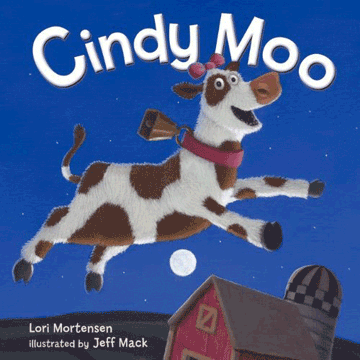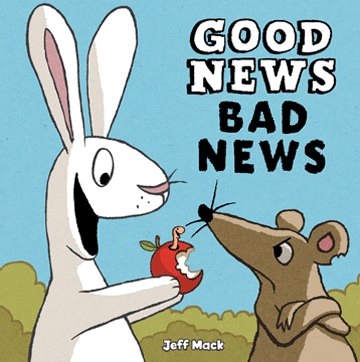Jeff Mack
Since 2003, Jeff Mack has written and illustrated more than forty picture books, chapter books, early readers, and graphic novels including the Clueless McGee series, Good News Bad News, Hush Little Polar Bear, Duck in the Fridge, and the Mr. Monkey series.
Some of his books have been awarded Junior Library Guild Selections, New York Public Library Best Books of the Year, Bank Street Books of the Year, and various state awards including the Colorado Bell and three Texas 2x2 awards.
He has also illustrated many books for other authors, including James Howe's Bunnicula and Friends series and Eve Bunting's Hurry! Hurry!
From his home in Western Massachusetts, he travels both nationally and internationally visiting schools and libraries where he shares his passion for creating books with young readers, writers, and artists.
Reviews and Awards
Time to Make Art
“There are many misconceptions about what art is and what it should do. An inquisitive brown-skinned girl wants to know more about art and asks a series of simple yet profound questions about it. Each question is answered by a different artist, ranging from ancient to modern, famous to regionally known. Unlike many art surveys, this book presents a truly global perspective, putting Indigenous and non-Western art side-by-side with well-known Western artists as well as conceptual and avant-garde work. The girl asks questions such as “Can nothing be art?”; “Art can also be sad, right?”; and “Can art be something that I use?” The answers depend on who is doing the responding. For the question “How long will it take to make art?” replies vary from a minute (Keith Haring) to an hour (Eric Carle) to a hundred hours (Christine Harvey). Should art look like what we see? An impressionist would answer with a hearty yes, but a post-impressionist like Van Gogh might think it’s better “when art looks like how I feel.” Digitally rendered illustrations feature each artist and something representative of their work. A thoughtful look at art that will likely motivate budding artists to trust their creative intuition. Back matter provides information on each artist and may spark hours of further research and discovery.”—The Horn Book, Starred Review
“As a brown-skinned young protagonist, sporting cornrows and a lavender beret, ponders the nature of creativity, palette and brush in hand, artists from around the world and throughout history respond. Pointing to God’s finger on the Sistine Chapel ceiling, the child wonders if art must be perfect. Michelangelo assures the child, “You can make your art any way you want.” The youngster discusses the use of color with Piet Mondrian, contemplates whether to privilege realism over other styles with René Magritte and Vincent van Gogh, and mulls the emotional content of art with Chris Ofili and Frida Kahlo. The diversity of talent and array of topics included are truly impressive. Vibrant handmade and digital illustrations portray a stone sculptor from 200 CE Teotihuacán, a cave artist, and Esther Mahlangu, a South African artist who applies traditional Ndebele house patterns on everything from jewelry to sneakers. The questions addressed are ones that will occur to most people of any age: What about mistakes? How do you know if your art is good? Leonardo da Vinci fields that last one: “Good art will be fun and mysterious…no matter how many times you see it.” Humor and wonder shine through in Mack’s intelligent, playful scenes. The book can be enjoyed without recognizing the artists (who go unnamed in the story itself), but backmatter identifies them and offers salient snippets for each. An inspiring and empowering manifesto for young creators.”—Kirkus, Starred Review
Marcel’s Masterpiece: How a Toilet Shaped the History of Art
“‘Come to dada!’ Beginning with the salvaged urinal Marcel Duchamp retitled “Fountain” and turned on its head to do the same to the stuffier reaches of the art world, this pun-tastic ramble through the realms of the “readymade” serves as both a quick history of Dadaism and a manifesto of its ideas. Mack’s collage illustrations combine statements of purpose in randomly colored block letters, patches of explanatory background distributed among clipped and layered images of both fustian and free-spirited museum goers, glimpses of Duchamp as both himself with some of his creations and his female alter ego Rrose Sélavy, celebrity cameos from the likes of Picasso and Warhol to John Cage, and a notably diverse array of modern children running around and getting excited about art. His point that art is any thing or concept that helps us think about our world in new and interesting ways—be it a centuries-old painting or the banana that Maurizio Cattelan taped to a wall in 2019 (“But why, Maurizio?” “It’s Got A Peel.”)—is made with freewheeling hilarity and thoroughly persuasive conviction.”—Booklist, Starred Review
“This picture book biography of French artist Marcel Duchamp (1887–1968) begins with his conceptualizing 1917’s Fountain, an upside down urinal displayed in a “fancy art show” in New York. Shown in Mack’s art as a wiry, straw-boater-sporting imp, Duchamp delights in the outrage and controversy that ensues, declaring, “Well, it did get people to think about art, didn’t it?” The book’s second half looks more broadly at Duchamp and his influence, including his Readymades; his alter ego, Rrose Sélavy; and the Dada movement with which he is associated, inviting readers to regard art in terms of “what ideas help us think about our world in new and interesting ways.” Mixed-media cartooned vignettes, punctuated with collaged elements, including the laugh-out-loud text itself (about visiting Fountain, figures mention needing “to go”), strike just the right balance of headiness and breezy mischievousness for a young audience—innate connoisseurs of épater le bourgeoisie.”—Publishers Weekly, Starred Review
“Marcel Duchamp’s use of a urinal to challenge assumptions about art in 1917 New York has inherent kid appeal—and Mack exploits the possibilities. The artist is first glimpsed holding a pen and standing next to Mona Lisa, who sports an inky mustache and goatee. Readers then see a star pattern shaved into Duchamp’s hair—examples of how a bizarre sensibility permeated his art. The book is primarily concerned, however, with the furor caused when Duchamp purchased the toilet from a sanitation company (“Come to Dada,” he croons affectionately) and submitted it to the “fancy art show.” Collages employ acrylics, watercolors, digital ink, and materials with interesting textures. The narrative is set on strips of colored paper, while the dialogue is presented in capital letters in different colors and fonts; some appear pasted on. These techniques are characteristic of the Dada art movement, contextualized in a more straightforward (but still engaging) addendum. The design is inspired. Potty humor and wordplay abound: “It says here there’s a toilet in an art show and everyone will be going.” Mack takes some liberties with the truth; the exhibition’s organizers actually excluded the piece from the show (it appeared in the catalog), whereas Mack has visitors reacting to it. This decision does focus attention on actual responses (people were amused or aghast at the concept) and on the questions Duchamp provoked about the nature of art. A funny, clever consideration of an iconic object.”—Kirkus Reviews, Starred Review
The Cryptid Club: Bigfoot Takes the Field
“In this inaugural title of a middle-grade comics series, siblings Lily and Henry encounter a mysterious cryptid known to many as Bigfoot, who is strangely interested in football and has recently been frequenting their schools' locker rooms. There have been rumors going around the halls of Thomas Edison Grade School of sightings of a strange creature in the boys locker room. However, Lily doesn't buy it; she works for the school newspaper and believes in facts. But after hearing of so many encounters, she decides it might be worth investigating. After interviewing a teacher who saw the creature with his own eyes, Lily decides to form a club with her brother and fellow-student Oliver, dedicated to cryptozoology, the study of cryptid creatures like the one visiting their school. Mack's comical, goggle-eyed figures have outsize emotions, and the frequent sight gags keep the tone cheery and light. A joke-filled monster story about being open-minded while examining the facts, The Cryptid Club checks all the right boxes.”—Booklist
Art is Everywhere: A Book About Andy Warhol
A Bulletin of the Center for Children’s Books “Blue Ribbon”
“As Warhol’s practice expands into silk screens, film, music, magazines, and television, Mack weaves in iconic details—Warhol’s penchant for wigs, collaboration, and mother—and sums up his worldview: “I think art is about liking things. It’s about seeing the things around us in a new way. Seeing them as pretty. EVERYTHING is pretty. Don’t you think?” Brushy artwork, benday-dot texture, and bright blotched color offer an age-appropriate taste of the Factory.” —Publishers Weekly, Starred Review
“Mack’s loose-lined, affectionately wacky tribute to Warhol’s pop art and media oeuvres is a vibrant visual hook, but it’s the provocative discussion starters that bring this title ebulliently to life.” —Bulletin of the Center for Children’s Books, Starred Review
Just a Story
"The deadpan text is a foil for the rowdy artwork, cheery scenes littered with clues for alert viewers." —Bulletin of the Center for Children's Books
Monkey Takes a Hike
"[A] delightful romp . . . a rollicking adventure." — School Library Journal
"Mack's mastery of repetition expertly recycles sentences (and a vocabulary of around 70 words), adding new meaning through illustration and context." —Kirkus Reviews
Duck on a Disco Ball
"A super-silly riff on a perennial question: What do grown-ups do while kids sleep?" —Kirkus Reviews
Mr. Monkey Visits a School
"Mack’s episodic story presentation and expressive physical comedy offer natural appeal for early readers." —Publishers Weekly
Mr. Monkey Bakes a Cake
"Monkey + banana = recipe for delicious cake…or delicious comedy? Encore, encore for kid lit's ap-peel-ing new primate." —Kirkus Reviews, Starred Review
"Mack kicks off an easy-reader series with a sweet and delicious romp."—Booklist
"Mack has another winner with this cross between a picture book and beginning reader. Kids will love hapless Mr. Monkey and root for his success all the while enjoying his amusing near-failures."—School Library Journal
Mine!
"A behavioral window for some, a mirror for many, and a delightful book for all." — Kirkus Reviews, Starred Review
Conceptually rich and a whole lot of fun."—School Library Journal
"A fun read-aloud." — Booklist
If My Love Were a Fire Truck
"This bedtime story reassures and entertains. A guaranteed hit for vehicle lovers." — School Library Journal
How Do You Say I Love You, Dewey Dew?
"A powerful message about the support of friends and defusing a bully wrapped in a sweet Valentine tale." —Kirkus Reviews
Look!
"This is a fun read-aloud that will have children wanting to look and look again."—School Library Journal
"The slapstick action unfolds on linen-textured backgrounds, battered vintage book covers, and the actual pages of a book—hat-tips to the physicality of books that hint at a happy ending for bibliophiles of all ages." —Publishers Weekly, Starred Review
"Look, indeed! An energetic invitation to the joys of books." —Kirkus Reviews









